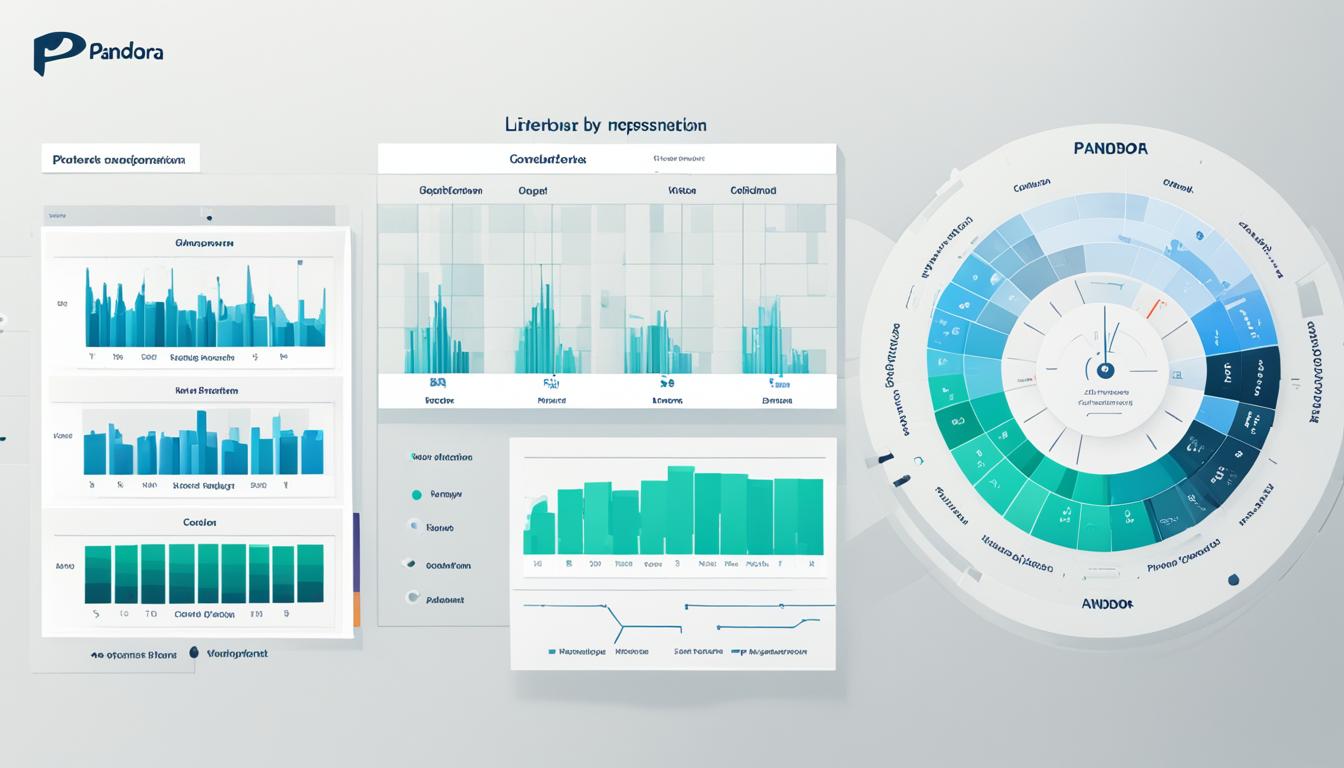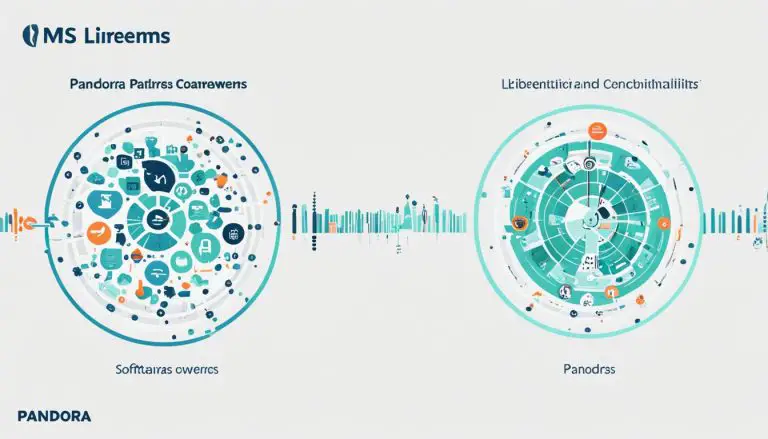LibreNMS vs. Pandora NMS: A Detailed Comparison
Are you searching for the perfect network monitoring tool to keep your organization’s network running smoothly? Look no further! In this article, I will be comparing LibreNMS and Pandora NMS, two leading network monitoring solutions. But here’s the burning question: Which one will meet your specific needs and help you achieve optimal network performance?
LibreNMS and Pandora NMS have garnered attention in the market for their robust features and capabilities. However, their differences lie in functionality, scalability, device support, customization options, and cost. By delving into these areas, we can discover which tool is the right one for your organization.
Key Takeaways:
- LibreNMS and Pandora NMS are powerful network monitoring tools.
- LibreNMS is an open-source solution with extensive device support and scalability.
- Pandora NMS offers comprehensive monitoring capabilities and proactive solutions.
- Factors to consider include network complexity, desired level of customization, and budget.
- Take advantage of free trials and demos to find the perfect fit for your organization.
About LibreNMS
LibreNMS is an open-source network monitoring solution with a comprehensive set of features for monitoring the health and performance of a network. It supports various network hardware and operating systems, making it highly versatile and adaptable to different environments. Whether you have a small network or a large enterprise infrastructure, LibreNMS offers scalability to meet your monitoring needs.
One of the key advantages of LibreNMS is its user-friendly design, which simplifies network management tasks. It automates network discovery through SNMP (Simple Network Management Protocol), enabling effortless identification and mapping of network devices. By reducing manual configuration efforts, LibreNMS streamlines the monitoring process and saves valuable time and resources.
With its web-based interface, LibreNMS provides a clean and intuitive platform for monitoring network status and managing configurations. From this centralized dashboard, you can easily view real-time reports on the performance of your network, identify issues, and implement proactive solutions to ensure optimal network stability and reliability.
LibreNMS offers a robust set of features for network monitoring, providing you with the tools you need to keep your network healthy and performant.
Key Features of LibreNMS
- Auto-discovery: Automatically detects and maps network devices using SNMP.
- Customizable alerting system: Set up personalized alerts and notifications for network anomalies.
- Distributed polling: Efficiently monitor larger networks by distributing monitoring tasks across multiple servers.
- Wide device support: Compatible with various network hardware and operating systems.
- Plugins and integrations: Extend functionality through the use of plugins and integrations with other tools.
- Web-based interface: Intuitive and user-friendly interface for easy monitoring and management.
- API access: Programmatically interact with LibreNMS for automation and integration purposes.
- Geographical maps: Visualize network topologies and monitor geographic locations of devices.
- Customizable dashboards: Tailor the monitoring experience to your specific needs and preferences.
LibreNMS empowers organizations with the necessary insights and tools to effectively monitor and manage their networks. By leveraging its rich set of features, you can proactively identify and address network issues, optimize performance, and ensure the stability of your network infrastructure.
Key Features of LibreNMS
LibreNMS offers a wide range of features that make it a powerful network monitoring tool for organizations of all sizes. Let’s explore some of its key features:
Auto-discovery
With its auto-discovery feature, LibreNMS simplifies the process of detecting and mapping devices in your network. Using SNMP, it automatically discovers and adds devices, saving you time and effort.
Customizable Alerting System
LibreNMS provides a customizable alerting system that allows you to set up alerts based on specific conditions. Whether it’s monitoring network bandwidth, CPU usage, or any other parameter, you can create complex alerting rules to stay informed about potential issues.
Distributed Polling
For larger networks, LibreNMS offers distributed polling, which allows you to distribute monitoring tasks across multiple servers. This ensures efficient monitoring and reduces the load on individual servers, improving overall performance.
Wide Device Support
One of the strengths of LibreNMS is its extensive device support. It is compatible with a wide range of network devices and operating systems, making it suitable for diverse network environments.
Plugins and Integrations
LibreNMS supports plugins and integrations, allowing you to extend its functionality and integrate it with other tools or systems. This flexibility enables you to enhance your network monitoring capabilities and streamline your workflows.
Web-based Interface
The web-based interface of LibreNMS provides a user-friendly platform for monitoring your network. It offers a clean and intuitive experience, allowing you to easily access network status, reports, and configurations from any device with a web browser.
API Access
LibreNMS provides API access, enabling you to integrate it with other systems or develop custom applications. This allows you to automate tasks, extract data, and further extend the capabilities of LibreNMS.
Geographical Maps
To visualize your network infrastructure, LibreNMS offers geographical maps. These maps display the geographic locations of your devices, providing a visual representation of your network’s physical layout.
Customizable Dashboards
With LibreNMS, you can create customizable dashboards that suit your specific monitoring needs. You can easily arrange widgets, charts, and graphs to gain insights into your network’s performance at a glance.
These are just a few of the key features that LibreNMS offers. Its extensive feature set, wide device support, and customizable nature make it a reliable choice for effective network monitoring and management.
Industries that Benefit from LibreNMS
LibreNMS is a powerful network monitoring tool that offers numerous benefits to various industries that rely on network stability and performance. By implementing LibreNMS, organizations in industries such as telecommunications, education, and healthcare can effectively monitor and manage their networks to ensure optimal performance and reliability.
Telecommunications companies depend on a stable network infrastructure to provide uninterrupted service to their customers. With LibreNMS, these companies can monitor network health, identify potential issues, and proactively resolve them to maintain network stability and minimize downtime.
In the education sector, network stability is crucial for seamless communication and access to online resources. LibreNMS enables educational institutions to monitor their networks in real-time, ensuring a smooth learning experience for students and faculty members.
Similarly, the healthcare industry relies heavily on network stability to support critical systems such as electronic health records and medical devices. By implementing LibreNMS, healthcare organizations can monitor their networks to prevent disruptions and ensure the secure transmission of patient data.
“The stability of network infrastructure is essential for industries that rely on uninterrupted connectivity.”
LibreNMS is highly scalable, making it suitable for both small and large networks. Whether it’s a telecommunications provider with a vast network spanning multiple locations or an educational institution with a smaller network infrastructure, LibreNMS can effectively monitor and manage networks of any size.
With its extensive device support, LibreNMS is capable of monitoring a wide range of network hardware and operating systems that are commonly used across different industries. This versatility ensures that businesses can seamlessly integrate LibreNMS into their existing network infrastructure without compatibility issues.
Furthermore, LibreNMS offers a flexible alerting system that allows organizations to set up custom alert rules based on specific network conditions. This proactive approach enables businesses to detect and address network issues promptly, minimizing the impact on operations and ensuring uninterrupted service for their customers.
Overall, by implementing LibreNMS, industries can proactively manage and troubleshoot their networks to maintain network stability, improve performance, and enhance the overall reliability of their network infrastructure.
About Pandora NMS
Pandora NMS is a monitoring as a service (MaaS) solution designed to cater to the needs of companies with a large number of devices. It offers a comprehensive suite of features and functions as an all-in-one solution for efficiently monitoring networks, applications, services, and more.
With its advanced capabilities, Pandora NMS simplifies the troubleshooting process by untangling complex technology infrastructures and identifying the root causes of issues. This enables organizations to resolve problems quickly and efficiently, minimizing downtime and maximizing system performance.
One of the key advantages of Pandora NMS is its ability to provide a comprehensive overview of the entire system. By monitoring all aspects of the network, applications, and services, organizations gain valuable insights into their infrastructure’s health and performance.
The software also offers proactive solutions for addressing potential issues before they escalate, allowing businesses to take preventive measures and maintain high levels of system availability. Moreover, Pandora NMS helps optimize services by providing real-time data and analytics to support informed decision-making for continuous improvement of the network infrastructure.
Key Features of Pandora NMS
Pandora NMS offers a comprehensive set of network monitoring features that cater to various aspects of network and system management. With Pandora NMS, organizations can effectively monitor their applications and ensure optimal performance. Let’s explore some key features of Pandora NMS:
- Application Monitoring: Pandora NMS allows for comprehensive monitoring of applications, ensuring their availability and performance. This feature helps organizations identify and address any issues or bottlenecks that may impact application performance.
- IoT Monitoring: With the rise of the Internet of Things (IoT), monitoring devices and sensors has become crucial. Pandora NMS provides dedicated capabilities to monitor and manage IoT devices, ensuring operational efficiency and minimizing downtime.
- Log Collection: Logs play a vital role in troubleshooting issues and identifying problems proactively. Pandora NMS offers log collection capabilities, enabling organizations to aggregate, analyze, and search logs from various sources within their network infrastructure.
- Inventory: Keeping track of network assets is essential for effective management. Pandora NMS provides a robust inventory feature that allows organizations to maintain a comprehensive database of their network devices and configurations.
- Issue Management: Pandora NMS streamlines the issue management process by providing a centralized platform for tracking, prioritizing, and resolving network issues. It allows organizations to efficiently handle incidents and minimize their impact on network performance.
- Mainframe Monitoring: In today’s hybrid and diverse IT environments, mainframe systems are crucial components. Pandora NMS supports monitoring mainframe systems alongside other network devices, providing a holistic view of the entire infrastructure.
- Network Monitoring: As a core feature, Pandora NMS excels at network monitoring. It offers comprehensive capabilities to monitor network health, traffic, and performance metrics. This enables organizations to quickly detect and address any network-related issues that may arise.
- Synthetic Monitoring: Synthetic monitoring allows organizations to simulate user interactions with applications and services. Pandora NMS enables comprehensive synthetic monitoring, helping organizations proactively identify and address potential issues that could impact user experience.
- Service-Oriented Monitoring: In today’s interconnected world, monitoring services and their dependencies is crucial. Pandora NMS provides service-oriented monitoring capabilities, allowing organizations to monitor service-level agreements (SLAs) and maintain high service availability.
- Server Monitoring: Pandora NMS offers robust server monitoring capabilities, allowing organizations to monitor server performance, availability, and resource utilization. This feature enables proactive identification of server issues and optimization of server resources.
- User Experience Monitoring: Understanding user experience is vital for optimizing application performance. Pandora NMS provides user experience monitoring capabilities, helping organizations gain insights into user behavior, application responsiveness, and overall satisfaction.
- Virtualization and Cloud Monitoring: With the increasing adoption of virtualization and cloud technologies, monitoring these environments has become essential. Pandora NMS offers capabilities to monitor virtualization platforms and cloud services, ensuring optimal performance and resource utilization.
As you can see, Pandora NMS offers a wide range of features for effective network monitoring and application monitoring. The tool’s versatility enables organizations to monitor various aspects of their network and system infrastructure, ensuring optimal performance, availability, and user experience.
Benefits of Using Pandora NMS

Implementing Pandora NMS offers numerous benefits for optimizing network and system performance. With its comprehensive set of features and functionalities, Pandora NMS enables organizations to proactively manage their networks and address issues before they escalate.
One key benefit of implementing Pandora NMS is its ability to provide a comprehensive overview of the system, making troubleshooting and issue resolution easier. By offering detailed insights into network health and performance, Pandora NMS helps identify and resolve potential problems quickly and efficiently.
Another advantage of Pandora NMS is its proactive solutions. The tool allows organizations to set up alerts and notifications based on specific metrics, enabling administrators to take immediate action to resolve issues before they impact system availability. This proactive approach helps ensure smooth system operations and minimizes downtime.
Furthermore, Pandora NMS offers optimization of services to minimize future problems. By continuously monitoring network performance and identifying areas for improvement, organizations can optimize their services and infrastructure to prevent future issues. This proactive approach helps maintain system availability and enhances the overall user experience.
Pandora NMS also provides personalized service maps that offer a visual representation of network infrastructure and dependencies. These service maps help identify shortcomings in the system, allowing organizations to prioritize and address critical areas that require attention. By having a clear understanding of the network’s structure and connections, administrators can make informed decisions to optimize system performance.
Pandora NMS offers SLA and availability reports for monitoring performance against business goals. These reports provide valuable insights into system availability and performance metrics, enabling organizations to ensure that their networks are meeting established service level agreements. By monitoring performance against business goals, organizations can identify areas for improvement and make data-driven decisions to enhance network and system operations.
In summary, Pandora NMS offers a wide range of benefits, including a comprehensive overview of the system for easy troubleshooting, proactive solutions to address issues before they escalate, optimization of services, personalized service maps for identifying shortcomings, and SLA and availability reports. By leveraging the capabilities of Pandora NMS, organizations can optimize their network and system performance to meet business goals and enhance the overall user experience.
Comparison of LibreNMS vs. Pandora NMS
When comparing LibreNMS and Pandora NMS, it’s essential to consider various factors, such as features, scalability, device support, customization options, and cost. Both tools provide comprehensive network monitoring capabilities but cater to different needs and requirements.
“LibreNMS is an open-source solution that is highly customizable and suitable for organizations of all sizes.”
LibreNMS stands out as an open-source network monitoring tool that offers extensive customization options. It allows users to tailor the tool to their specific needs and preferences. This flexibility makes it an ideal choice for organizations of all sizes, from small businesses to large enterprises.
“Pandora NMS, on the other hand, is a robust Monitoring as a Service (MaaS) solution that caters more towards larger organizations with complex infrastructures.”
Pandora NMS, on the other hand, is a powerful Monitoring as a Service (MaaS) solution that offers a wide range of monitoring features. With its ability to handle complex infrastructures and manage a large number of devices, Pandora NMS is well-suited for larger organizations with extensive network environments.
While both LibreNMS and Pandora NMS provide comprehensive network monitoring capabilities, each has its own strengths and weaknesses. The choice between the two ultimately depends on the specific needs and requirements of your organization.
In addition to customization options and scalability, it’s important to consider other factors such as the level of device support, available integrations, ease of use, and pricing structure.
By thoroughly evaluating these factors and conducting a thorough comparison, you can make an informed decision and choose the network monitoring tool that best aligns with your organization’s goals and objectives.
Conclusion
In conclusion, the network monitoring tool comparison between LibreNMS and Pandora NMS reveals two powerful solutions with unique features and capabilities. LibreNMS stands out with its open-source nature, scalability, and extensive device support, making it suitable for organizations of all sizes. On the other hand, Pandora NMS offers a comprehensive monitoring solution with advanced features and proactive solutions. The choice between the two ultimately depends on the specific needs and requirements of the organization, such as budget, network complexity, and desired level of customization.
Both LibreNMS and Pandora NMS provide comprehensive network monitoring capabilities, enabling organizations to monitor and manage network infrastructure effectively. Whether it’s monitoring network health, detecting and resolving issues, or optimizing performance, these tools offer the functionality required to ensure smooth network operations.
The decision-making process should involve careful consideration of factors such as scalability, device support, customization options, and cost. Organizations should evaluate their specific needs and goals to determine which tool aligns best with their requirements.
LibreNMS, as an open-source solution, offers flexibility and adaptability, making it an attractive option for organizations seeking customization and extensive device support. Its scalability allows it to grow alongside the network infrastructure, ensuring long-term suitability.
Pandora NMS, on the other hand, offers a wealth of monitoring capabilities and proactive solutions. Its ability to untangle complex infrastructures and identify root causes of issues streamlines troubleshooting and problem resolution, enhancing system availability and performance.
Ultimately, the final decision should factor in the organization’s budget, network complexity, and desired level of customization. Implementing a comprehensive network monitoring tool is crucial for businesses to maintain network stability, optimize performance, and proactively address potential issues.
By leveraging a network monitoring solution like LibreNMS or Pandora NMS, organizations can monitor, analyze, and optimize their networks, ensuring smooth operations and minimizing downtime.
When selecting a network monitoring tool, it is essential to thoroughly evaluate the features, scalability, device support, customization options, and cost. Utilizing free trials and demos can allow organizations to test the tools and make an informed decision.
In summary, network monitoring tools play a critical role in maintaining the stability and performance of networks. Both LibreNMS and Pandora NMS offer strong options, each with its own unique strengths and capabilities. By carefully assessing the specific needs and requirements of the organization, businesses can select the tool that best aligns with their goals and objectives.
Final Thoughts
When choosing a network monitoring tool, it is important to carefully assess the specific needs and requirements of your organization. Factors such as scalability, device support, customization options, and cost should be taken into consideration. Both LibreNMS and Pandora NMS offer comprehensive monitoring capabilities that can meet the demands of different organizations.
LibreNMS, being an open-source solution, offers great flexibility and scalability, making it suitable for organizations of all sizes. With its extensive device support and customizable features, it provides the freedom to tailor the tool according to your organization’s goals and objectives.
Pandora NMS, on the other hand, is a robust monitoring as a service (MaaS) solution that excels in complex and large-scale infrastructures. It offers a wide range of monitoring features and proactive solutions to optimize system performance and ensure maximum efficiency.
Ultimately, the final decision should be based on a thorough evaluation of your organization’s unique requirements. Take advantage of free trials and demos to test out both tools and see which one aligns best with your needs. By selecting the right network monitoring tool, you can enhance the stability, security, and performance of your network infrastructure.
FAQ
How does LibreNMS compare to Pandora NMS?
What are the key features of LibreNMS?
Which industries benefit from implementing LibreNMS?
What are the key features of Pandora NMS?
What are the benefits of implementing Pandora NMS?
How do I choose between LibreNMS and Pandora NMS?
- About the Author
- Latest Posts
Janina is a technical editor at Text-Center.com and loves to write about computer technology and latest trends in information technology. She also works for Biteno.com.




